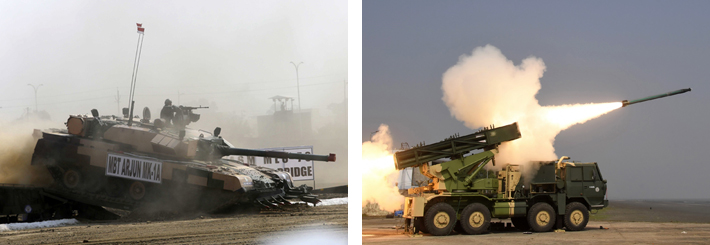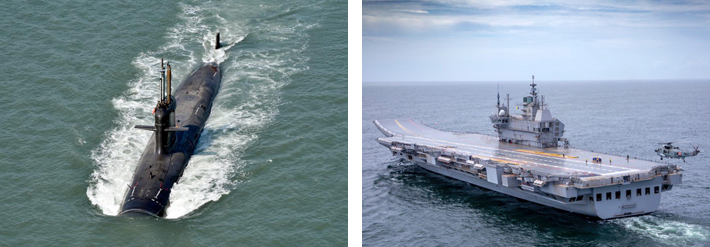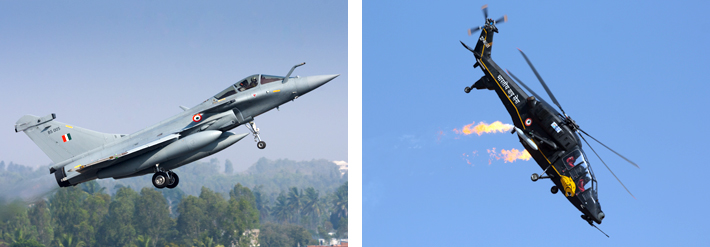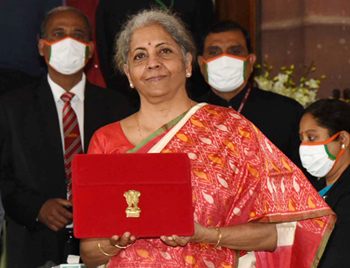The crux of a defence budget should be to systematically improve the military's capability to meet future threats in keeping with the changing battlefield environments in the 'shortest possible period'
 |
The Author is Former Director General of Information Systems and A Special Forces Veteran, Indian Army |
(File Photo) Nirmala Sitharaman Minister of Finance and Corporate Affairs of India presenting the Year 2021-22 Budget
The budget for the next financial year is scheduled to be presented on February 1, 2022. Going by the last few years, defence may not find any mention at all in the finance minister’s speech. Alternatively, with the kick delivered by China in Ladakh, at best it may be said that there will be no dearth of funds to cater for requirements of the Armed Forces. This incidentally has also been said in previous years albeit ‘after’ the budget was announced. If that was the case, there would have been no mad rush to plug operationally emergent voids when the Chinese invaded in 2020.
The process to decide on the defence budget will likely be the same as was followed in the last few years – Services Headquarters forward their demands to HQ Integrated Defence Staff (IDS) who compile it and forward it to the Ministry of Defence (MoD). The MoD after affixing their signatures sends it to the Ministry of Finance (MoF). The MoF appreciates how much money should be spent to earn maximum vote banks and how much can be ‘spared’ for defence.
It is left to the MoD to decide how much money should be for capital expenditure including new acquisitions while pending installments for previous capital acquisitions also have to be accommodated
It is left to the MoD to decide how much money should be for capital expenditure including new acquisitions while pending installments for previous capital acquisitions also have to be accommodated. The Armed Forces are required to make do with the leftovers for modernisation. It does not matter if they have to shut down some ongoing programmes on which years and tonnes of finances have been already spent.
The Armed Forces Long Term Integrated Perspective Plan (LTIPP) covers a period of 15 years. It identifies the shape and size of the forces over the designated time period based on foreseeable strategic trends. From this document, flows the five year plans which translate the LTIPP into an action plan with supposedly ‘committed funding’. But the flaws in this are: LTIPP is made in absence of a national security strategy (NSS) and a strategic defence review (SDR); the Defence Minister’s Annual Directive hardly qualifies as defence policy and at times is not even revised annually; though the LTIPP is submitted in advance, the MoD approves it 4-5 years after or even later from commencement of the 15-year period covered by it, and; the ‘committed funding’ for the 5-year plan is misnomer because the poor annual budgetary allocation doesn’t allow it.

(From Left to Right) MBT Arjun Mk-1A and Enhanced PINAKA rocket
With the looming China threat, Japan’s defence spending for 2021 reached the largest-ever amount of Yen 5.40 trillion ($4.69 billion) and Taiwan’s Parliament has recently passed an extra spending bill of $8.6 billion. In India, much is in the news about the fastest digital survey done of the defence land. Someone may even be given a reward for it. Lakhs of crores of rupees are being harvested by selling what has been termed “surplus defence land” through the politico-bureaucratic skullduggery in concert with the self-serving army hierarchy. This land will be sold under the euphemism of ‘transfer’ to various organisation and individuals both official and private. But as the present Finance Minister had said in her previous avatar as the Defence Minister, not one penny of this would come to the defence budget.
Given our history, financial allocations for defence will continue to be minimal. But we should not lose sight of the need to build operational capabilities in relation to an accurately and holistically appreciated threat profile.
There is little point in writing that given the threat envelope India’s defence budget should be 3-3.5 per cent of GDP for the next few years to build requisite defence capability. Many scholars have been recommending this over the years, without any effect on the hierarchy. The threats fizzle out in thin air amid politicians boasting we can take Pakistan occupied Kashmir (POK) in 10 days, with the military hierarchy nodding their head, and that we will take Aksai Chin while we were found wanting in Eastern Ladakh during the 2020 Chinese aggression with the People’s Liberation Army merrily pushing the Line of Actual Control (LAC) further westwards in our territory.

(From Left to Right) Fourth Scorpene Submarine ‘Vela’ and Indigenous Aircraft Carrier (P71) Vikrant
Given our history, financial allocations for defence will continue to be minimal. Simultaneously, the media will howl about the pension bill but without mentioning the expenditure on other services and how much even the civil-defence employees make with NFU and the like. But we should not lose sight of the need to build operational capabilities in relation to an accurately and holistically appreciated threat profile. This is all the more important with Defence Minister Rajnath Singh recently stating that the possibility of conflict cannot be ruled out – anything can happen.
While we acknowledge that information warfare, electronic warfare are increasingly important and space, cyber and the electromagnetic will affect every facet of conflict, the defence expenditure underpinned by economic constraints will need to ensure ‘maximum output with minimum expenses’; covering capabilities required to meet the entire spectrum of conflict. Concurrently we also need a policy of ‘obsolescence’. For example, the logic that every aircraft flying is serviceable is fine but then we have lost some 450 pilots in MiG-21 crashes over the past six decades. Isn’t it time to retire the MiG-21 and provide the four squadrons holding them with modern fighter jets?
The defence expenditure underpinned by economic constraints will need to ensure ‘maximum output with minimum expenses’, covering capabilities required to meet the entire spectrum of conflict
The crux of a defence budget should be to systematically improve the military’s capability to meet future threats in keeping with the changing battlefield environments in the ‘shortest possible period’. In the US, the Services don’t just forward their budgetary demands to higher authorities. The Theatre Commanders and Commander of the Special Operations Command (SOCOM) make individual presentations to the Senate Committee on Armed Services; highlighting what is their present operational capability, budgetary allotment they are bidding for and if that money is allotted to them in what measure the operational capability of their respective command will improve. It is the Senate Committee on Armed Services that forwards the budgetary demand to the US Congress.

(From Left to Right) Rafale and Light Combat Helicopter
The above system is what India needs irrespective of what percentage of GDP the eventual demand turns out to be. In such a system the government becomes aware what the capabilities of the military are and how much it needs to be improved. We have the Parliamentary Standing Committee on Defence (SCOD); a department related standing committee (DRSC) of selected members of parliament, constituted by our Parliament, for the purpose of legislative oversight of the defence policies and decision making of the Ministry of Defence (MOD).
Unfortunately, the Parliamentary Standing Committee on Defence (SCOD) has little say in matters military and its recommendations are generally trashed
Unfortunately, the SCOD has little say in matters military and its recommendations are generally trashed with media making some brief mention of their recommendation. If the Chairman of SCOD makes too much noise he gets replaced, as happened in the case of veteran Major General B.C. Khanduri despite his being a Member of Parliament of the ruling party and even a Union Minister in the previous government. Not only should the Chairman and maximum members of the SCOD should have military background, advice of the SCOD should be binding on the government. The SCOD should be processing the defence budget like done in the US by the Senate Committee on Armed Services.
Indian governments must get serious about matters military and defence allocations to avoid situations like the firefighting procurements in wake of the Chinese aggression in Eastern Ladakh during 2020. We need to streamline the procedure taking cognizance of the future operational requirements.













